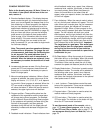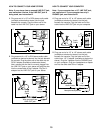
20
WEIGHT BENCH EXERCISE GUIDELINES
HOW TO ADJUST THE BACKREST
The backrest can be adjusted to any of four positions:
the inclined (upright) position, the semi-inclined posi-
tion, the flat position, and the declined position.
To adjust the backrest, first adjust the seat to the
farthest forward position (see HOW TO ADJUST
THE SEAT on page 9). Next, pull out the adjustment
pin. Pivot the backrest to the desired position, and
then insert the pin into one of the holes in the rounded
brackets and the corresponding hole in the seat car-
riage (see the inset drawing). Note: When the backrest
is in the declined position, the seat will also be declined.
CAUTION: Never sit on the backrest or the head-
rest; doing so could cause the crosstrainer to tip,
resulting in injury.
STRENGTH TRAINING GUIDELINES
The weight bench can be used for a variety of exercis-
es designed to trim, tone, and strengthen the body.
Please read these guidelines before using the weight
bench.
It is recommended that your strength training program
include 3 workouts each week. Note: You may wish to
use the weight bench and the recumbent cycle on
alternating days. For example, plan weight training
workouts on Tuesday, Thursday, and Saturday, and
plan aerobic workouts on Monday, Wednesday, and
Friday. Make sure to rest for at least one full day each
week to give your body time to regenerate. CAUTION:
It is very important to avoid overdoing it during the
first few months of your exercise program, and to
progress at your own pace.
Begin each workout with five to eight minutes of
stretching and light exercise to warm up. A proper
warm-up increases your body temperature, heart rate,
and circulation in preparation for exercise.
After warming up, perform a selection of weight train-
ing exercises. The chart on the backrest shows four
exercises that can be performed. Consult a reputable
book to find other exercises that can be performed
using hand weights and a weight bench. To give bal-
ance to your workouts, vary the exercises from work-
out to workout. Begin with 1 set of 12 repetitions for
each exercise. (A “repetition” is one complete cycle of
an exercise, such as one sit-up. A “set” is a series of
repetitions performed without a pause.) As your fitness
level increases, perform 2 or 3 sets for each exercise.
Always rest for at least 1 minute after each set. When
you can complete 3 sets of 12 repetitions without diffi-
culty, you may choose to use heavier weights.
CAUTION: The crosstrainer includes three pairs of
hand weights. Do not use other weights with the
crosstrainer.
Finish each workout with five to eight minutes of
stretching to cool down. This will increase your flexibility
and will help to prevent soreness.
EXERCISE FORM
For the best results, correct form is important.
Maintaining proper form means moving through the full
range of motion for each exercise, and moving only
the appropriate parts of the body. Make sure to per-
form each exercise with a smooth, steady motion.
Exhale as you exert yourself, and inhale as you return
to the starting position; never hold your breath.
STAYING MOTIVATED
For motivation, try listening to music or watching tele-
vision while you exercise. Use a calendar to keep a
record of your workouts, and record key body mea-
surements at the end of every month. Remember, the
key to lasting results is to make exercise a regular and
enjoyable part of your daily life.
WARNING: Before beginning any
exercise program, consult your physician.
This is especially important for persons over
the age of 35 or persons with pre-existing
health problems.
Backrest
Seat
Decline
Flat
Semi-inclined
Brackets
Inclined
Pin


















